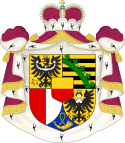Third Josef Hoop cabinet
Third Josef Hoop cabinet | |
|---|---|
Government of Liechtenstein | |
 | |
| Date formed | 30 March 1938 |
| Date dissolved | 9 November 1944 |
| People and organisations | |
| Head of state | Franz Joseph II |
| Head of government | Josef Hoop |
| Deputy head of government | Alois Vogt |
| Total no. of members | 5 |
| Member parties | FBP VU |
| History | |
| Election(s) | 1939 |
| Predecessor | Second Josef Hoop cabinet |
| Successor | Fourth Josef Hoop cabinet |
 |
|---|
| ||
|---|---|---|
|
Prime Minister of Liechtenstein 1928–1945   |
||
The third Josef Hoop cabinet was the governing body of Liechtenstein from 30 March 1938 to 9 November 1944. It was appointed by Franz Joseph II and chaired by Josef Hoop.
History[edit]
Following the Anschluss of Austria in March 1938 Franz I named his nephew Franz Joseph his regent.[1] The Progressive Citizens' Party and Patriotic Union formed a coalition government formed to prevent government deadlock and help retain Liechtenstein's neutrality overseen by Franz Joseph II.[2][3] As a result, the Second Josef Hoop cabinet was succeeded with Josef Hoop continuing as Prime Minister of Liechtenstein.[4][5]
Starting from 1938, the cabinet was faced with the challenge of Swiss pressure to transfer the Ellhorn mountain to Switzerland. Though Hoop was supportive of the transfer he argued that the country should be fairly compensated for the loss of territory, such as the transfer of Swiss land elsewhere or greater banking cooperation between the two countries. The proposition faced resistance from the residents in Balzers, and was not approved by Franz Joseph II.[6][7] Also facing unofficial objections from Nazi Germany, Hoop was forced to end the negotiations with Switzerland.[8]
Though there was the 1939 Liechtenstein general election it was not made public due to the country being under threat from Nazi Germany. It became known as the "silent election" as no voting actually took place.[9] Instead, the Progressive Citizen's Party and Patriotic Union used to it assign roughly an equal number of seats to each other in order to prevent the German National Movement in Liechtenstein (VBDL) from gaining any seats in the Landtag of Liechtenstein.[10] As a result, the Hoop cabinet was now made out of several members of both parties.[5] Though the government was placed under threat when the VBDL attempted a coup in March 1939, first trying to provoke a intervention from Nazi Germany by burning swastikas, followed by declaring Liechtenstein's annexation into Germany. The leaders were almost immediately arrested and the hoped-for German invasion failed to materialise.[11][12]
During World War II, Liechtenstein remained neutral. Hoop's government considered non-binding, non-provocative diplomacy to be appropriate towards Nazi Germany, supplemented by courtesy gestures. In 1940, during a lecture in Stuttgart, Hoop showed respect for the German armies.[13] At the same time, the country tied itself as closely as possible to Switzerland during the war in hopes of retaining the country's neutrality.[14] It achieved the de-facto inclusion of Liechtenstein in the Swiss national supply.[13]
At the request of Franz Joseph II on 9 November 1944, the cabinet was dissolved and succeeded by the Fourth Josef Hoop cabinet.[5]
Members[edit]
| Picture | Name | Term | Party | ||
|---|---|---|---|---|---|
| Prime Minister | |||||

|
Josef Hoop | 30 March 1938 – 9 November 1944 | Progressive Citizens' Party | ||
| Deputy Prime Minister | |||||

|
Alois Vogt | 30 March 1938 – 9 November 1944 | Patriotic Union | ||
| Government councillors | |||||

|
Anton Frommelt | 30 March 1938 – 9 November 1944 | Progressive Citizens' Party | ||
| Arnold Hoop | 30 March 1938 – 1940 | Patriotic Union | |||

|
Johann Georg Hasler | 13 August 1941 – 9 November 1944 | Patriotic Union | ||
See also[edit]
References[edit]
- ^ "Prince Franz to Return to Estate". Daily News. 1 April 1938. p. 216. Archived from the original on 20 April 2020 – via Newspapers.com.
- ^ Tikkanen, Amy (21 April 2023). "Francis Joseph II, prince of Liechtenstein". Britannica. Retrieved 15 May 2023.
- ^ Marxer, Wilfried (31 December 2011). "Patriotic Union (VU)". Historisches Lexikon des Fürstentums Liechtenstein (in German). Retrieved 14 May 2023.
- ^ Dieter Nohlen; Philip Stöver (2010). Elections in Europe: A data handbook (in German). p. 1164. ISBN 978-3-8329-5609-7.
- ^ a b c Paul Vogt (1987). 125 Jahre Landtag. Vaduz: Landtag of the Principality of Liechtenstein.
- ^ Meier, Günther (11 December 2023). "Die Angst vor feindlichen Truppen: Wie die «Loreley des Alpenrheins» den Besitzer wechselte". Neue Zürcher Zeitung (in German). Retrieved 30 March 2024.
- ^ Peter Geiger (2000). Krisenzeit. Liechtenstein in den Dreissigerjahren 1928–1939 (in German). Vol. 2. Vaduz: Liechtenstein Institute.
- ^ Büchel, Donat (31 December 2011). "Ellhorn". Historisches Lexikon des Fürstentums Liechtenstein (in German). Retrieved 19 March 2024.
- ^ Dieter Nohlen; Philip Stöver (2010). Elections in Europe: A data handbook (in German). p. 1159. ISBN 978-3-8329-5609-7.
- ^ Dieter Nohlen; Philip Stöver (2010). Elections in Europe: A data handbook (in German). p. 1179. ISBN 978-3-8329-5609-7.
- ^ Büchel, Donat (31 December 2011). "Anschlussputsch". Historisches Lexikon des Fürstentums Liechtenstein (in German). Retrieved 14 November 2023.
- ^ "Liechtenstein Jails Nazi For Attempt at Uprising". The New York Times. 27 April 1939. Retrieved 18 May 2023.
- ^ a b Peter Geiger (31 December 2011). "Hoop,_Josef_(1895–1959)". Historisches Lexikon des Fürstentums Liechtenstein (in German). Retrieved 26 October 2022.
- ^ Streitwireless, Clarence (10 April 1938). "GUARANTEE SOUGHT BY LIECHTENSTEIN; Principality Wants to Join Switzerland if Powers Fail to Back Independencece GERMAN INVASION FEARED". The New York Times. Retrieved 16 May 2023.

